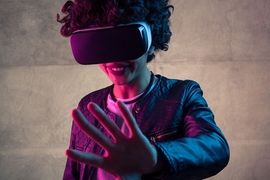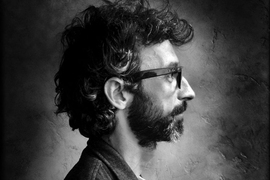Virtual reality (VR) technologies are having a growing impact on people's everyday lives. Sanjay Sarma, vice president for open learning, and D. Fox Harrell, professor of digital media and artificial intelligence in the Comparative Media Studies Program and the Computer Science and Artificial Intelligence Laboratory, have combined their efforts to launch MIT Open Learning’s new initiative, the MIT Center for Advanced Virtuality. The new initiative will help determine how MIT can use a group of technologies including virtual and mixed reality (collectively called extended reality or XR) to better serve human needs through artful innovation of virtual experiences, on-campus and beyond.
Harrell’s research explores the relationship between imagination and computation and involves developing new forms of computational narrative, gaming, social media, and related digital media based in computer science, cognitive science, and digital media arts. Harrell announced the creation of the center, which he will direct, in his remarks at this month’s “Human-Computer Interaction Salon and Mixer,” as part of the Computational Cultures Initiative, sponsored by the School of Humanities, Arts, and Social Sciences.
“The center’s mission is to pioneer innovative experiences using technologies of virtuality,” Harrell said. “Such technologies, ranging from Virtual Reality (VR) to Mixed Reality (MR) and beyond, all use computing to construct imaginative experiences atop our physical world. We endeavor to design and understand how these systems impact how we now communicate, express, learn, play, and work.”
The center — “MIT Virtuality” for short — will bring faculty, researchers, and VR professionals together to create new models for the deployment of impactful XR learning. The center will focus on creation, research, and innovation, through its Studio, Lab, Salon, and Hub functionalities.
The Studio, Harrell explained, will bring professionals and faculty together to innovate new uses for XR, while the Lab will investigate the impacts of these technologies, focusing on learning, simulation and cognition. The Salon and Hub will focus on capacity building and resource sharing, pairing students and experts with resources that will help expand VR technologies across MIT.
Sarma is ethusiastic about the new venture. “AR and VR are new ways of seeing and experiencing, and will be a key tool in changing and improving how we learn,” he said. “This center will advance fundamental research and application of virtual technologies in teaching, training and work.”
MIT Virtuality aims to enhance the production, research, and innovation capacity of VR at MIT, while investigating the social and ethical impacts of technologies as they are being innovated. Anyone interested in more information is encouraged to visit MIT Virtuality online.










